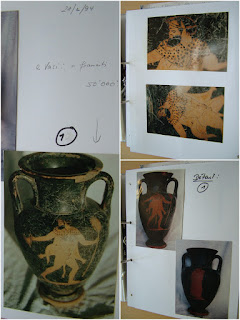Thursday, March 09, 2017 -  art crime exhibit,Carabinieri Tutela Patrimonio Culturale,Christo Michaelides,exhibit,Freeport,giacomo medici,Robin Symes,the medici conspiracy
art crime exhibit,Carabinieri Tutela Patrimonio Culturale,Christo Michaelides,exhibit,Freeport,giacomo medici,Robin Symes,the medici conspiracy
 No comments
No comments
 art crime exhibit,Carabinieri Tutela Patrimonio Culturale,Christo Michaelides,exhibit,Freeport,giacomo medici,Robin Symes,the medici conspiracy
art crime exhibit,Carabinieri Tutela Patrimonio Culturale,Christo Michaelides,exhibit,Freeport,giacomo medici,Robin Symes,the medici conspiracy
 No comments
No comments
Exhibition: When a school transforms itself into a museum: Preserving Italian heritage: recovered artefacts on display from 9 March to 30 April 2017 at the Rome International School
Following the success of the “Pop Icons” exhibition, the Rome International School in collaboration with MiBACT and the Comando Carabinieri Tutela Patrimonio Culturale will host a new cultural event in Rome, Italy highlighting the work of the Italian art crime military squad.
Starting today, and running through April 30th, the Rome International School will host 75 archaeological items, recovered from illegal excavations and thefts
recovered by this special branch of the Carabinieri.
On hand for today's press conference was Commander of the Comando Carabinieri Tutela Patrimonio Culturale, General Fabrizio Parrulli, the Director General of LUISS Guido Carli University (the parent school to the RIS), and Giovanni Lo Storto, Director General, MiBACT.
If you ever wanted irrefutable proof that a large, well trained police force can have an impact on art crimes, this exhibition, both visually and emotionally, hands you unrefutable evidence on a plate.
Want to whet your appetite to what you will see on display?
Here are a few of the artworks which stand out:
An attic red-figure pelike depicting Hercules in the garden of the Hesperides, and on the reverse side, a scene from the Iliupersis, also known as the sacking of Troy. This IV century BCE ceramic storage jar, similar to an amphora, was illegally excavated from somewhere in Puglia/Sicilia/Sardegna/Calabria. It was recovered during "Operation Teseo" a multinational police operation which recovered 5,361 antiquities confiscated in Basel, Switzerland.
Here are a few of the artworks which stand out:
An attic red-figure pelike depicting Hercules in the garden of the Hesperides, and on the reverse side, a scene from the Iliupersis, also known as the sacking of Troy. This IV century BCE ceramic storage jar, similar to an amphora, was illegally excavated from somewhere in Puglia/Sicilia/Sardegna/Calabria. It was recovered during "Operation Teseo" a multinational police operation which recovered 5,361 antiquities confiscated in Basel, Switzerland.
A 340-320 BCE crater with a representation of Helios on his sun chariot pulled by horses. This vase was seized during a raid against an antiquities dealer in 2009.
An illegally excavated III-I century BCE sarcophagus with a full-length portrait of a man reclining on a kline from clandestine excavation conducted in Southern Etruria dear Tuscania. One of the largest objects in this exhibition, the sarcophagus was recovered from an art storage warehouse in Switzerland in 2016 as part of Operation Antiche Dimore, a law enforcement seizure of 45 shipping crates belonging to Robin Symes which contained ancient works of art worth an estimated € 9 million that the disgraced dealer intended for the English market, Japanese and American antiquities markets.
A fresco slab looted from a tomb in historic Casertano depicting an armed warrior on horseback along with two heavily armed hoplite (foot-soldiers). The work was recovered from the storage area of an antiquities dealer in Como, Italy in May 2015.
A specific installation dedicated to ancient armour, which includes ancient suits of armour and weapons that originate from different parts of Italy, between the 5th and 6th centuries BCE.
The exhibition builds a bridge between the culture of the past, the culture of the future and the culture of legality. The last ultimately protects the rights of all of us to enjoy the knowledge and beauty that we have inherited from centuries long past.
For more information about the event please visit the RIS website.

























